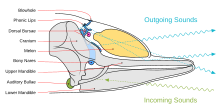Echo
This article needs additional citations for verification. (July 2023) |
In audio signal processing and acoustics, an echo is a reflection of sound that arrives at the listener with a delay after the direct sound. The delay is directly proportional to the distance of the reflecting surface from the source and the listener. Typical examples are the echo produced by the bottom of a well, by a building, or by the walls of an enclosed room and an empty room.
Etymology
The word echo derives from the Greek ἠχώ (ēchō),[1] itself from ἦχος (ēchos), 'sound'.[2] Echo in Greek mythology was a mountain nymph whose ability to speak was cursed, leaving her able only to repeat the last words spoken to her.
Nature

Some animals use echo for location sensing and navigation, such as cetaceans (dolphins and whales) and bats in a process known as echolocation. Echoes are also the basis of sonar technology.
Acoustic phenomenon
Acoustic waves are reflected by walls or other hard surfaces, such as mountains and privacy fences. The reason of reflection may be explained as a discontinuity in the

The human ear cannot distinguish echo from the original direct sound if the delay is less than 1/10 of a second.[3] The velocity of sound in dry air is approximately 343 m/s at a temperature of 25 °C. Therefore, the reflecting object must be more than 17.2m from the sound source for echo to be perceived by a person located at the source. When a sound produces an echo in two seconds, the reflecting object is 343m away. In nature, canyon walls or rock cliffs facing water are the most common natural settings for hearing echoes. The strength of echo is frequently measured in sound pressure level (SPL) relative to the directly transmitted wave. Echoes may be desirable (as in systems).
Use of echo
In
Echo in music
In music performance and recording, electric echo effects have been used since the 1950s. The

